2015 DODGE CHALLENGER transmission oil
[x] Cancel search: transmission oilPage 93 of 603
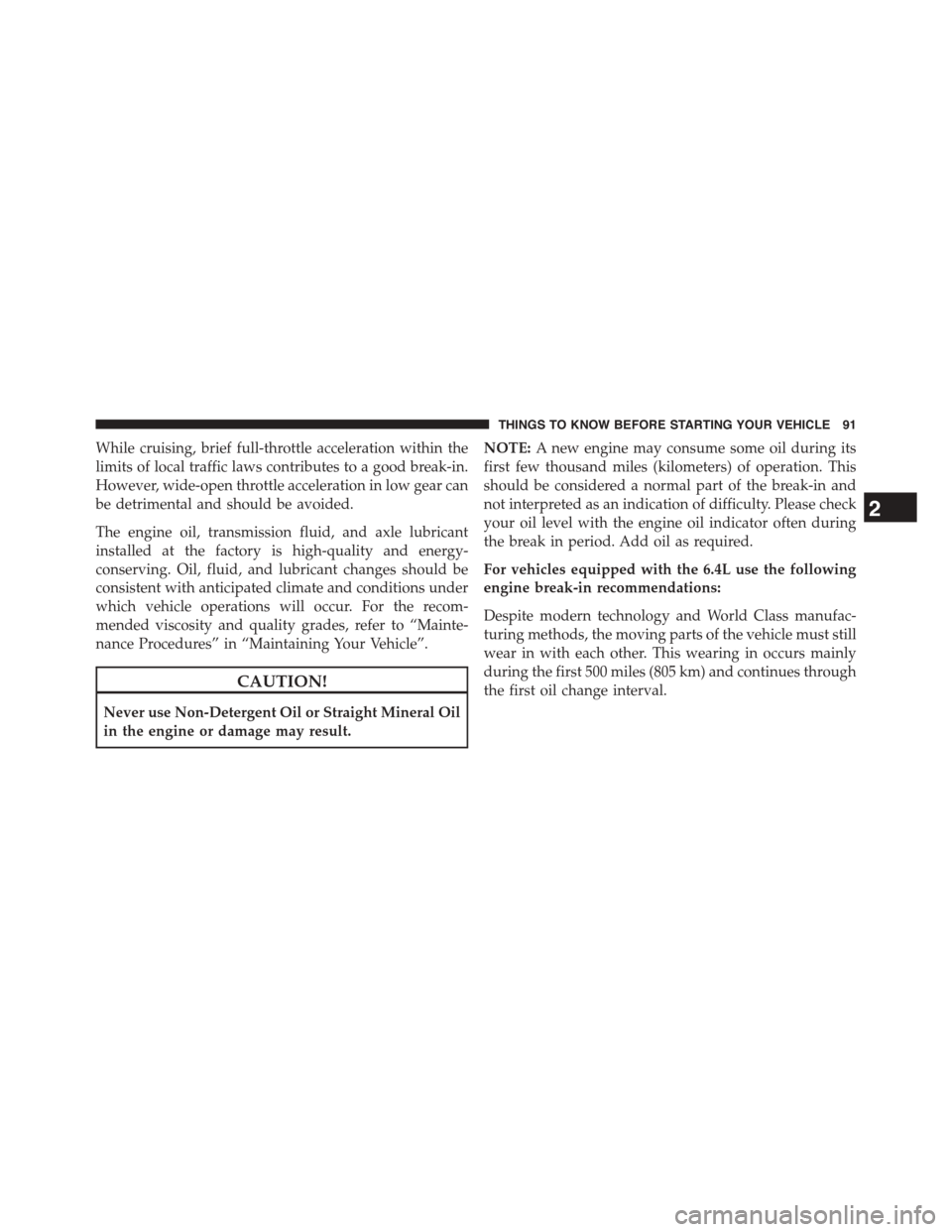
While cruising, brief full-throttle acceleration within the
limits of local traffic laws contributes to a good break-in.
However, wide-open throttle acceleration in low gear can
be detrimental and should be avoided.
The engine oil, transmission fluid, and axle lubricant
installed at the factory is high-quality and energy-
conserving. Oil, fluid, and lubricant changes should be
consistent with anticipated climate and conditions under
which vehicle operations will occur. For the recom-
mended viscosity and quality grades, refer to “Mainte-
nance Procedures” in “Maintaining Your Vehicle”.
CAUTION!
Never use Non-Detergent Oil or Straight Mineral Oil
in the engine or damage may result.
NOTE:A new engine may consume some oil during its
first few thousand miles (kilometers) of operation. This
should be considered a normal part of the break-in and
not interpreted as an indication of difficulty. Please check
your oil level with the engine oil indicator often during
the break in period. Add oil as required.
For vehicles equipped with the 6.4L use the following
engine break-in recommendations:
Despite modern technology and World Class manufac-
turing methods, the moving parts of the vehicle must still
wear in with each other. This wearing in occurs mainly
during the first 500 miles (805 km) and continues through
the first oil change interval.
2
THINGS TO KNOW BEFORE STARTING YOUR VEHICLE 91
Page 298 of 603
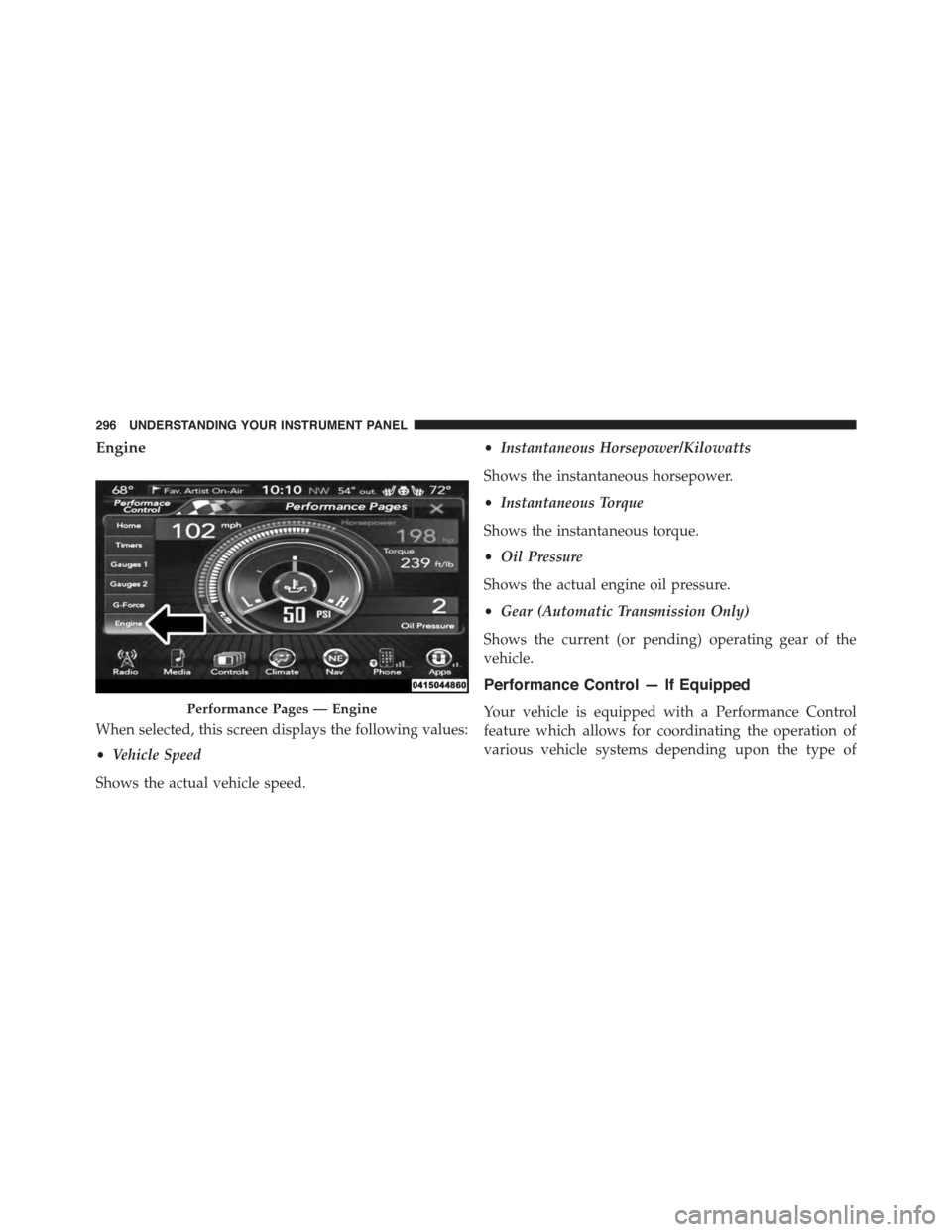
Engine
When selected, this screen displays the following values:
•Vehicle Speed
Shows the actual vehicle speed.
•Instantaneous Horsepower/Kilowatts
Shows the instantaneous horsepower.
•Instantaneous Torque
Shows the instantaneous torque.
•Oil Pressure
Shows the actual engine oil pressure.
•Gear (Automatic Transmission Only)
Shows the current (or pending) operating gear of the
vehicle.
Performance Control — If Equipped
Your vehicle is equipped with a Performance Control
feature which allows for coordinating the operation of
various vehicle systems depending upon the type of
Performance Pages — Engine
296 UNDERSTANDING YOUR INSTRUMENT PANEL
Page 461 of 603
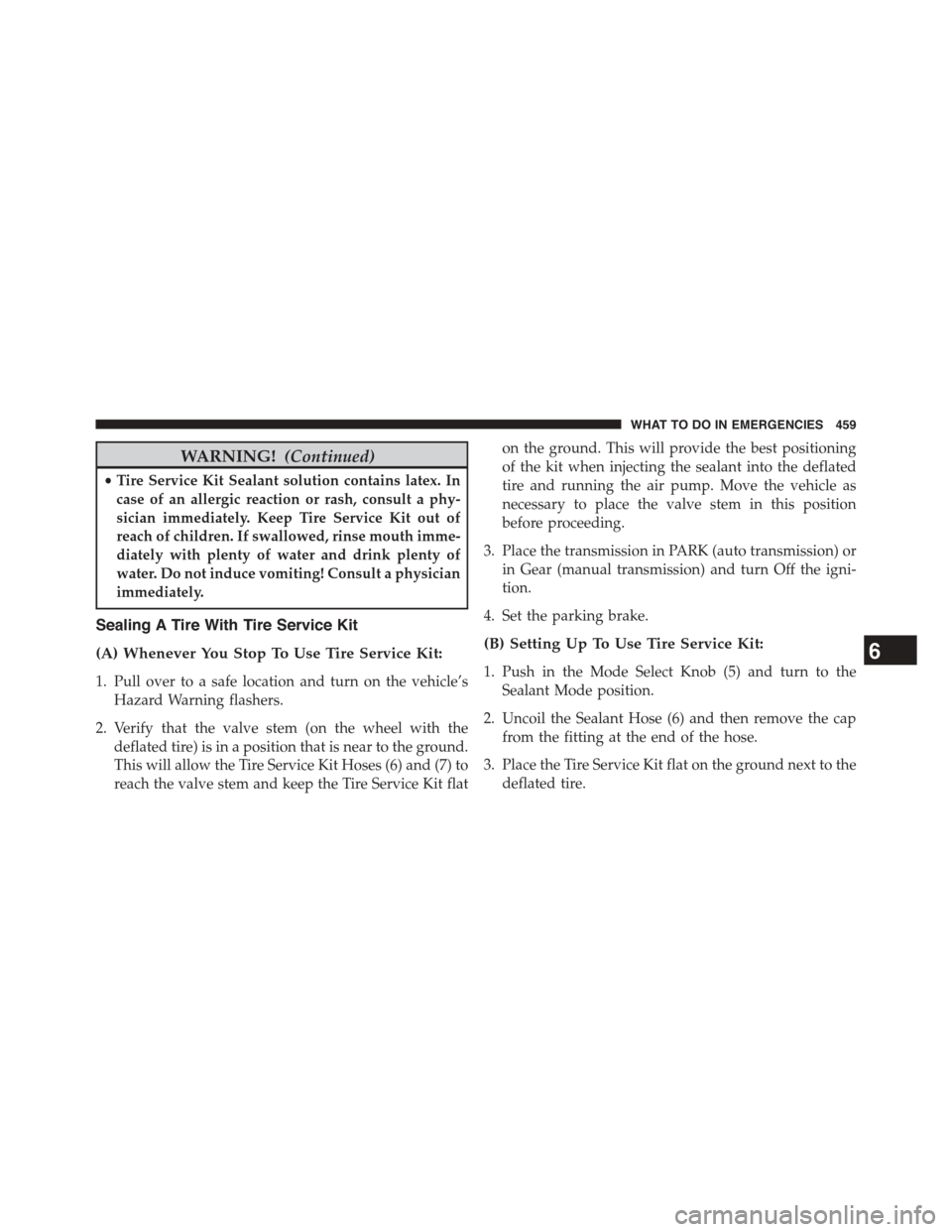
WARNING!(Continued)
•Tire Service Kit Sealant solution contains latex. In
case of an allergic reaction or rash, consult a phy-
sician immediately. Keep Tire Service Kit out of
reach of children. If swallowed, rinse mouth imme-
diately with plenty of water and drink plenty of
water. Do not induce vomiting! Consult a physician
immediately.
Sealing A Tire With Tire Service Kit
(A) Whenever You Stop To Use Tire Service Kit:
1. Pull over to a safe location and turn on the vehicle’s
Hazard Warning flashers.
2. Verify that the valve stem (on the wheel with the
deflated tire) is in a position that is near to the ground.
This will allow the Tire Service Kit Hoses (6) and (7) to
reach the valve stem and keep the Tire Service Kit flat
on the ground. This will provide the best positioning
of the kit when injecting the sealant into the deflated
tire and running the air pump. Move the vehicle as
necessary to place the valve stem in this position
before proceeding.
3. Place the transmission in PARK (auto transmission) or
in Gear (manual transmission) and turn Off the igni-
tion.
4. Set the parking brake.
(B) Setting Up To Use Tire Service Kit:
1. Push in the Mode Select Knob (5) and turn to the
Sealant Mode position.
2. Uncoil the Sealant Hose (6) and then remove the cap
from the fitting at the end of the hose.
3. Place the Tire Service Kit flat on the ground next to the
deflated tire.
6
WHAT TO DO IN EMERGENCIES 459
Page 462 of 603
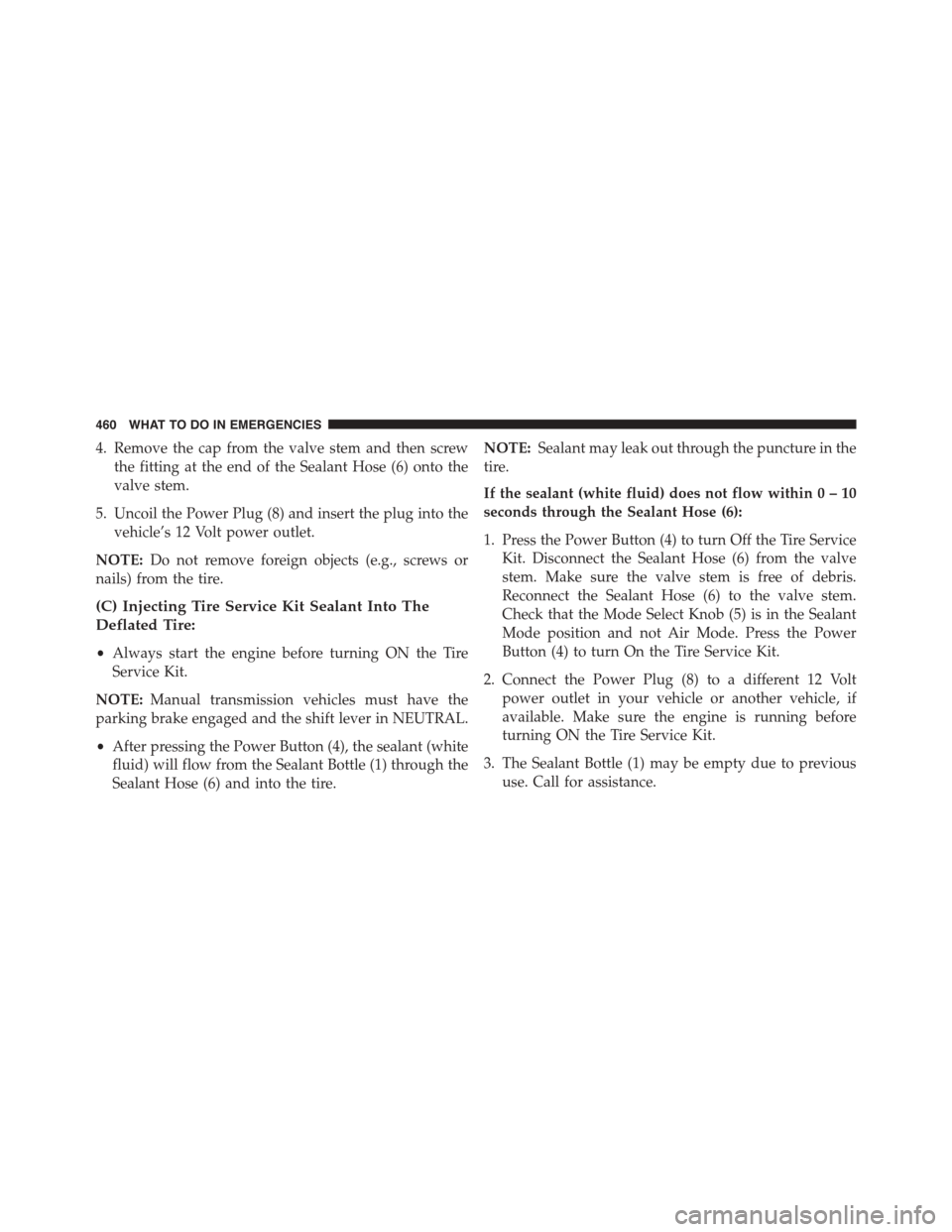
4. Remove the cap from the valve stem and then screw
the fitting at the end of the Sealant Hose (6) onto the
valve stem.
5. Uncoil the Power Plug (8) and insert the plug into the
vehicle’s 12 Volt power outlet.
NOTE:Do not remove foreign objects (e.g., screws or
nails) from the tire.
(C) Injecting Tire Service Kit Sealant Into The
Deflated Tire:
•Always start the engine before turning ON the Tire
Service Kit.
NOTE:Manual transmission vehicles must have the
parking brake engaged and the shift lever in NEUTRAL.
•After pressing the Power Button (4), the sealant (white
fluid) will flow from the Sealant Bottle (1) through the
Sealant Hose (6) and into the tire.
NOTE:Sealant may leak out through the puncture in the
tire.
If the sealant (white fluid) does not flow within0–10
seconds through the Sealant Hose (6):
1. Press the Power Button (4) to turn Off the Tire Service
Kit. Disconnect the Sealant Hose (6) from the valve
stem. Make sure the valve stem is free of debris.
Reconnect the Sealant Hose (6) to the valve stem.
Check that the Mode Select Knob (5) is in the Sealant
Mode position and not Air Mode. Press the Power
Button (4) to turn On the Tire Service Kit.
2. Connect the Power Plug (8) to a different 12 Volt
power outlet in your vehicle or another vehicle, if
available. Make sure the engine is running before
turning ON the Tire Service Kit.
3. The Sealant Bottle (1) may be empty due to previous
use. Call for assistance.
460 WHAT TO DO IN EMERGENCIES
Page 498 of 603
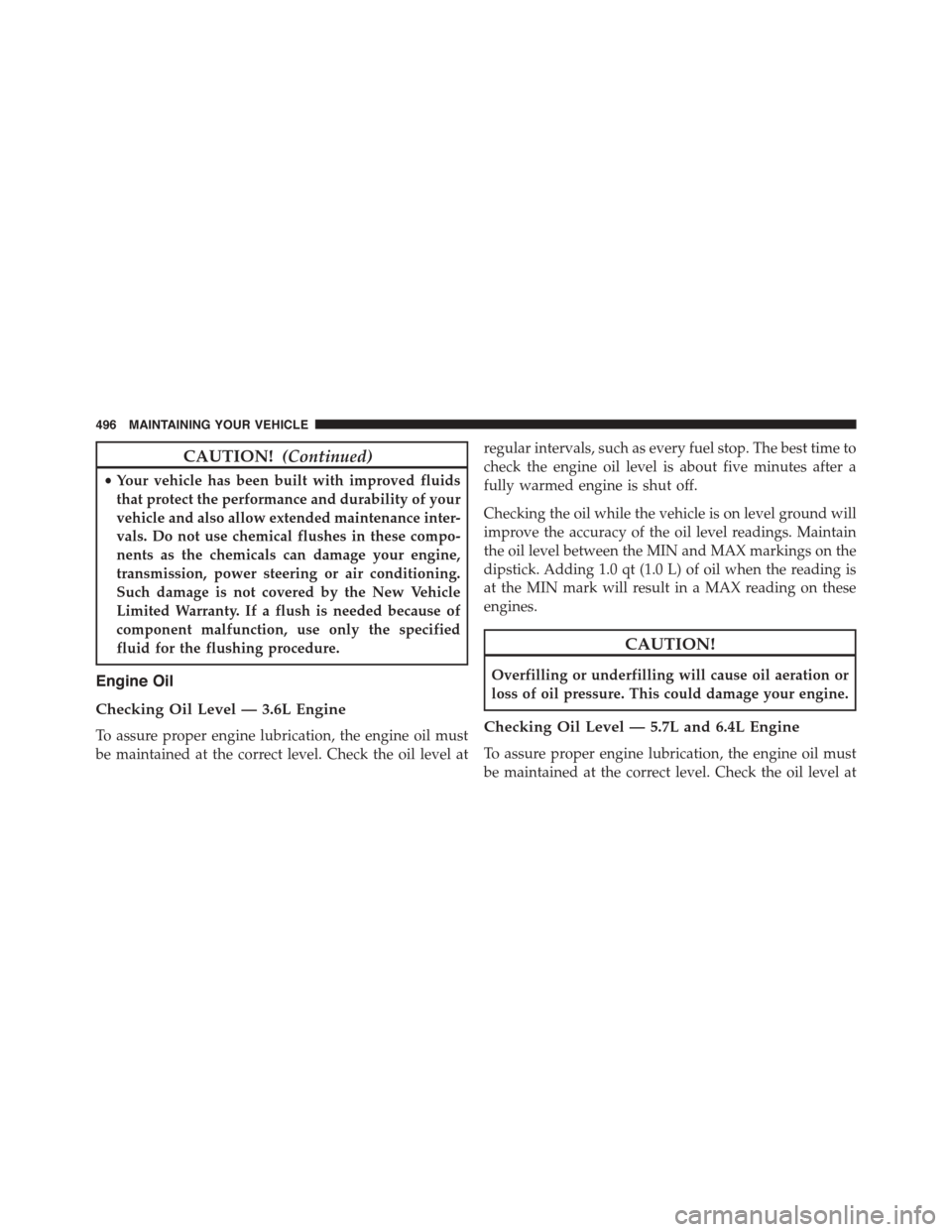
CAUTION!(Continued)
•Your vehicle has been built with improved fluids
that protect the performance and durability of your
vehicle and also allow extended maintenance inter-
vals. Do not use chemical flushes in these compo-
nents as the chemicals can damage your engine,
transmission, power steering or air conditioning.
Such damage is not covered by the New Vehicle
Limited Warranty. If a flush is needed because of
component malfunction, use only the specified
fluid for the flushing procedure.
Engine Oil
Checking Oil Level — 3.6L Engine
To assure proper engine lubrication, the engine oil must
be maintained at the correct level. Check the oil level at
regular intervals, such as every fuel stop. The best time to
check the engine oil level is about five minutes after a
fully warmed engine is shut off.
Checking the oil while the vehicle is on level ground will
improve the accuracy of the oil level readings. Maintain
the oil level between the MIN and MAX markings on the
dipstick. Adding 1.0 qt (1.0 L) of oil when the reading is
at the MIN mark will result in a MAX reading on these
engines.
CAUTION!
Overfilling or underfilling will cause oil aeration or
loss of oil pressure. This could damage your engine.
Checking Oil Level — 5.7L and 6.4L Engine
To assure proper engine lubrication, the engine oil must
be maintained at the correct level. Check the oil level at
496 MAINTAINING YOUR VEHICLE
Page 552 of 603
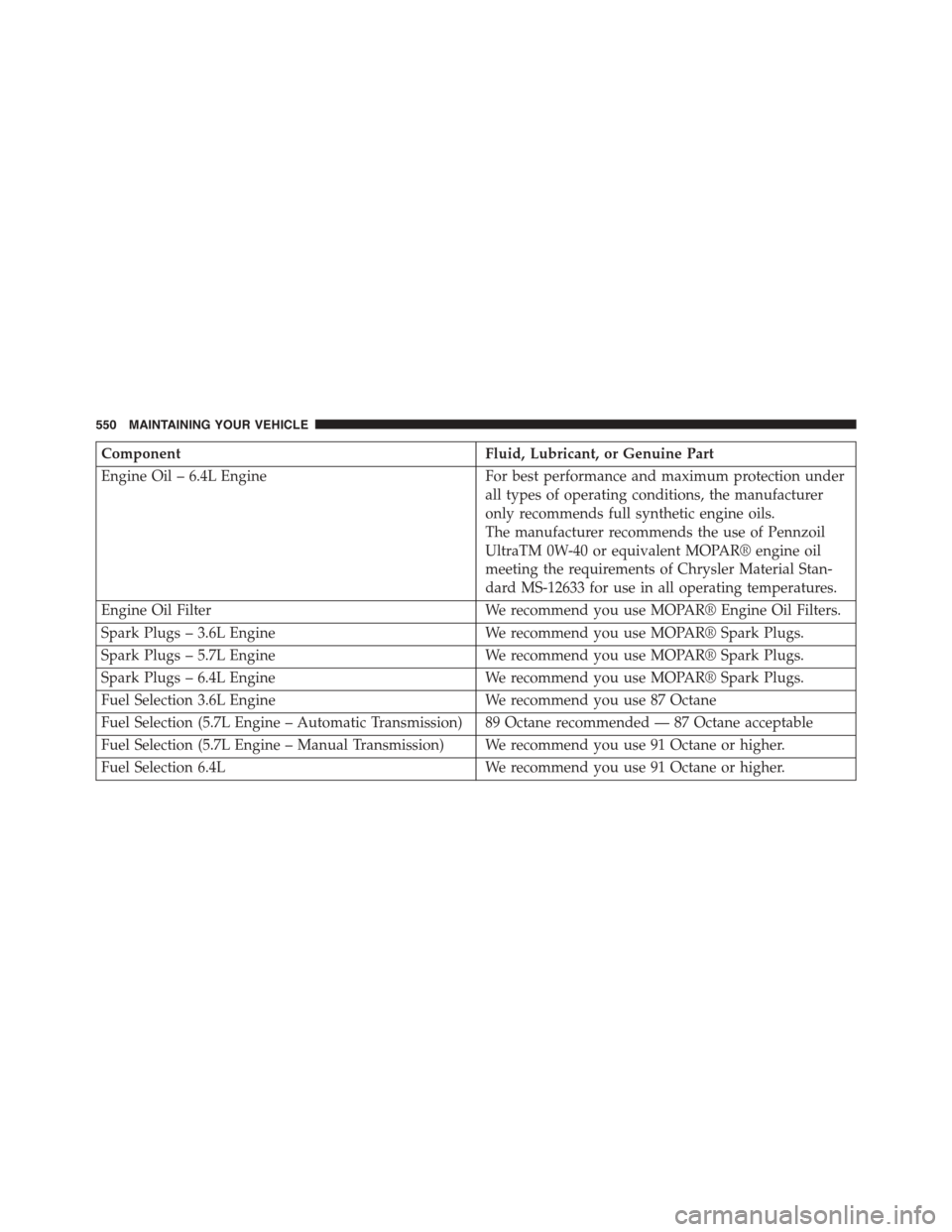
ComponentFluid, Lubricant, or Genuine Part
Engine Oil – 6.4L EngineFor best performance and maximum protection under
all types of operating conditions, the manufacturer
only recommends full synthetic engine oils.
The manufacturer recommends the use of Pennzoil
UltraTM 0W-40 or equivalent MOPAR® engine oil
meeting the requirements of Chrysler Material Stan-
dard MS-12633 for use in all operating temperatures.
Engine Oil FilterWe recommend you use MOPAR® Engine Oil Filters.
Spark Plugs – 3.6L EngineWe recommend you use MOPAR® Spark Plugs.
Spark Plugs – 5.7L EngineWe recommend you use MOPAR® Spark Plugs.
Spark Plugs – 6.4L EngineWe recommend you use MOPAR® Spark Plugs.
Fuel Selection 3.6L EngineWe recommend you use 87 Octane
Fuel Selection (5.7L Engine – Automatic Transmission) 89 Octane recommended — 87 Octane acceptable
Fuel Selection (5.7L Engine – Manual Transmission) We recommend you use 91 Octane or higher.
Fuel Selection 6.4LWe recommend you use 91 Octane or higher.
550 MAINTAINING YOUR VEHICLE
Page 584 of 603

Anti-Lock (ABS)........................382
Fluid Check...........................518
Master Cylinder........................518
Parking..............................377
Warning Light.........................227
Brake/Transmission Interlock.................361
Break-In Recommendations, New Vehicle.........90
Brightness, Interior Lights...................145
Bulb Replacement.........................543
Bulbs, Light..............................97
Camera, Rear............................195
Capacities, Fluid..........................548
Caps, Filler
Fuel.................................431
Oil (Engine)...........................499
Radiator (Coolant Pressure)................515
Carbon Monoxide Warning...................94
Cargo (Vehicle Loading)....................433
Car Washes.............................524
Cellular Phone...........................312
Center High Mounted Stop Light..............547
Certification Label.........................433
Chains, Tire.............................415
Changing A Flat Tire.......................466
Chart, Tire Sizing.........................393
Check Engine Light (Malfunction Indicator Light) . .493
Checking Your Vehicle For Safety...............93
Checks, Safety............................93
Child Restraint............................69
Child Restraints
Booster Seats...........................74
Center Seat LATCH......................82
Child Restraints.........................69
Child Seat Installation.....................87
How To Stow An Unused ALR Seat Belt........83
Infants And Child Restraints................72
Install A LATCH-compatible Child Restraint.....82
582 INDEX
Page 588 of 603

Filters
Air Cleaner...........................501
Air Conditioning.......................325
Engine Oil............................501
Engine Oil Disposal.....................500
Flashers................................453
Hazard Warning........................453
Turn Signal............................97
Flash-To-Pass............................144
Flooded Engine Starting....................352
Fluid, Brake.............................552
Fluid Capacities..........................548
Fluid Leaks..............................97
Fluid Level Checks
Automatic Transmission..................522
Brake................................518
Cooling System.........................512
Engine Oil............................496
Fluids, Lubricants and Genuine Parts...........549
Fog Lights..............................142
Folding Rear Seat.........................134
Forward Collision Warning..................183
Freeing A Stuck Vehicle.....................479
Fuel...................................425
Adding..............................431
Additives.............................429
Clean Air.............................427
Ethanol..............................427
Filler Cap (Gas Cap).....................431
Gasoline..............................425
Gauge...............................229
Materials Added........................429
Methanol.............................427
Octane Rating..........................425
Requirements..........................425
Specifications..........................549
Tank Capacity..........................548
Fueling................................431
586 INDEX